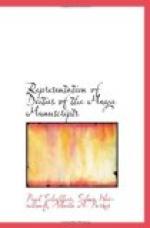3. THE DOG.
[Illustration: Fig. 60]
Fig. 60 is its hieroglyph. It is the symbol of the death-god and the bearer of the lightning. The latter follows quite clearly from the picture in Dr. 40b where the god is distinguished by its hieroglyph. This animal is again represented in Dr. 7a, 13c on the right, 21b with its hieroglyph, 29a, 30a (forming a part of 31a, where god B holds the bound dog by the tail), and 39a without the hieroglyph, 47 (bottom) with a variant of the hieroglyph.
In Dr. 36a the dog bears the Akbal-sign on its forehead. The writing above it contains a variant of the hieroglyph for the dog; this is the third of the rubric. It shows (somewhat difficult of recognition) the Akbal-sign on the forehead of the dog’s head occurring in it, and on the back of the head the Kin-sign, as symbols of the alternation of day and night. The same sign occurs again with adjuncts in Dr. 74 (last line, 2nd sign) and once with the death-god in Dr. 8a. The dog as lightning-beast occurs with the Akbal-sign in the eye instead of on the forehead in Codex Tro. 23*a; here again its hieroglyph is an entirely different one (the third of the rubric).
That the dog belongs to the death-god is proved beyond a doubt by the regular recurrence in the writing belonging to the dog, of the hieroglyphs, which relate to this deity, especially of Fig. 5. According to Foerstemann his day is Oc.
4. THE VULTURE.
[Illustration: Fig. 61]
This bird is distinctly pictured as a mythological figure in Dr. 8a. It appears again, in feminine form, together with the dog, in Dr. 13c and also in 19a. In the first passage, its hieroglyph is almost effaced; the hieroglyph is very striking and occurs nowhere else in the whole collection of manuscripts. The body of this animal-deity is striped black and white; in Dr. 38b it is almost entirely black. The same passage displays a second hieroglyph for this figure (Fig. 61); this hieroglyph also occurs with the numeral 4 in Dr. 56b. In Dr. 36b this bird of prey is pictured fighting with the serpent; its hieroglyph occurs in the second form; the serpent is designated by the Chuen, the gaping jaws of the serpent (first character of the rubric).




